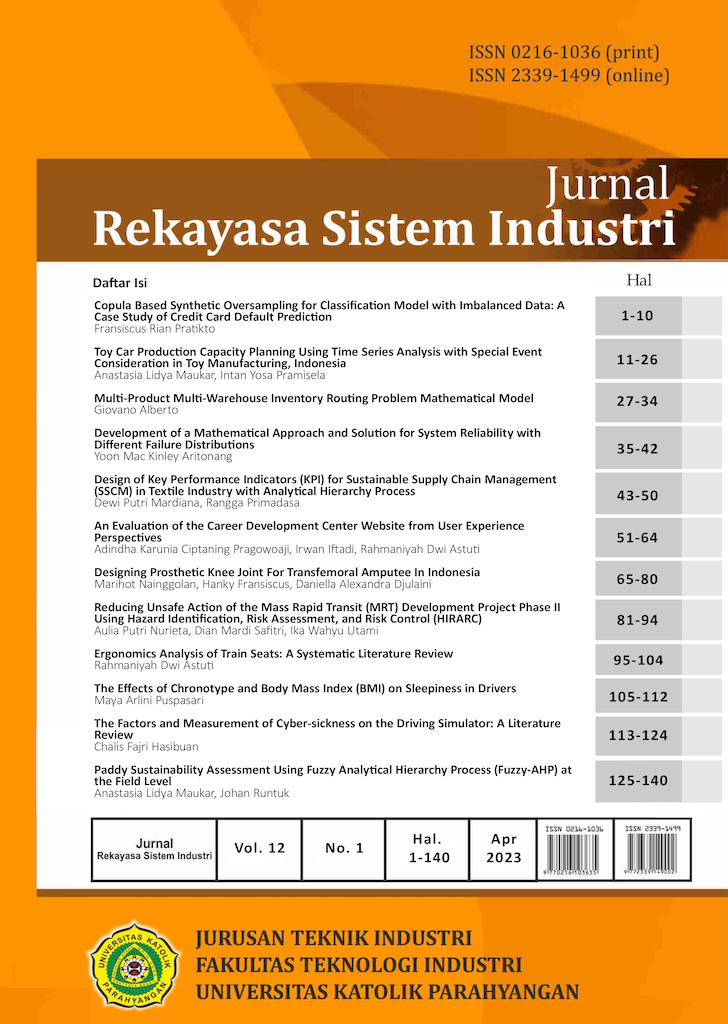Design of Key Performance Indicators (KPI) for Sustainable Supply Chain Management (SSCM) in Textile Industry with Analytical Hierarchy Process
DOI:
https://doi.org/10.26593/jrsi.v12i1.5549.43-50Keywords:
key performance indicators, AHP, textile industry, sustainable supply chain management, triple bottom lineAbstract
This paper aims to design Key Performance Indicators (KPI) to evaluate sustainable supply chain management (SSCM) in the textile industry in Indonesia. Supply chain sustainability has various challenges in supply chain management from an environmental, social and economic perspective. This encourages better performance management.The method used in identifying SSCM KPIs in the textile industry is carried out by surveys and field studies and validation of the respondent's questionnaire assessment, there are 20 SSM KPIs obtained during direct research in one of the textile industries in Kudus City. Precision performance is obtained by assessing the level of importance between KPI indicators measured using the Analytical Hierarchy Process (AHP) method. According to respondents' preferences, the most dominant indicators are economic indicators, followed by environmental indicators and then social indicators. The results of these KPIs are used to measure the performance of SSCM in the textile industry and as a reference for recommendations for performance improvement.
References
Anonim (2021) Indonesia Textiles Industry - Growth, Trends, Covid-19 Impact, And Forecasts (2021 - 2026). Available at: https://www.mordorintelligence.com/industry-reports/indonesia-textiles-industry# (Accessed: 4 October 2021).
BPS (2021) Data Ekspor Impor terbaru adalah data bulan Agustus 2021, BPS. Available at: https://www.bps.go.id/exim/ (Accessed: 4 October 2021).
Detiar, R. et al. (2021) ‘Pencegahan Dampak Lingkungan Pada Industri Pewarnaan Melalui Pendekatan Penilaian Siklus Daur Produk’, Jurnal Serambi Engineering, 6(3), 1953–1959. doi: 10.32672/jse.v6i3.3039.
Falak Medina, A. (2020) Indonesia’s Textile and Garment Industry: Opportunities for Foreign Investors, ASEAN BRIEFING. Available at: https://www.aseanbriefing.com/news/indonesias-textile-garment-industry-opportunities-foreign-investors/ (Accessed: 4 October 2021).
Gbolarumi, F. T., Wong, K. Y. and Olohunde, S. T. (2021) ‘Sustainability Assessment in The Textile and Apparel Industry: A Review of Recent Studies’, IOP Conference Series: Materials Science and Engineering, 1051(1), 012099. doi: 10.1088/1757-899x/1051/1/012099.
Herman (2019) Industri Tekstil Hadapi Tantangan Biaya Produksi, Berita Satu. Available at: https://www.beritasatu.com/ekonomi/574641/industri-tekstil-hadapi-tantangan-biaya-produksi.
Indonesia, C. (2019) ‘Sri Mulyani Beberkan Problem Industri Tekstil Selain Impor’, CNN Indonesia. Available at: https://www.cnnindonesia.com/ekonomi/20191005084909-532-436921/sri-mulyani-beberkan-problem-industri-tekstil-selain-impor.
Kishor, R. et al. (2021) ‘Ecotoxicological and health concerns of persistent coloring pollutants of textile industry wastewater and treatment approaches for environmental safety’, Journal of Environmental Chemical Engineering, 9(2), 105012. doi: 10.1016/j.jece.2020.105012.
Kusrini, E. and Primadasa, R. (2017) ‘Design of Key Performance Indicators (KPI) for Sustainable Supply Chain Management (SSCM) Palm Oil Industry in Indonesia’, ResearchGate.
Mauliza and Andriyani, D. (2020) ‘Analisis Kurs Dan Produksi Tekstil Terhadap Impor Tekstil Di Indonesia’, 04, 57–64.
Nayoan, J. R. et al. (2021) ‘Pembuatan Busana Berkualitas Dari Limbah Tekstil Melalui Brand Ciclo . Th Menggunakan Teknik Mixed Media’, 10(2), 63–67.
Prologis (2021) THE IMPORTANCE OF SUSTAINABILITY IN SUPPLY CHAIN MANAGEMENT. Available at: https://www.prologis.com/what-we-do/resources/sustainability-in-supply-chain-management (Accessed: 9 October 2021).
Saputra, A. and Sofiyanurriyanti, S. (2021) ‘Analisis Kepuasan Pelanggan terhadap Kualitas Pelayanan Jasa Ekspedisi dengan Metode Servqual dan Data Envelopment Analysis (DEA) di Kota Meulaboh’, Jurnal Sistem Teknik Industri, 23(1), 82–96. doi: 10.32734/jsti.v23i1.4773.

